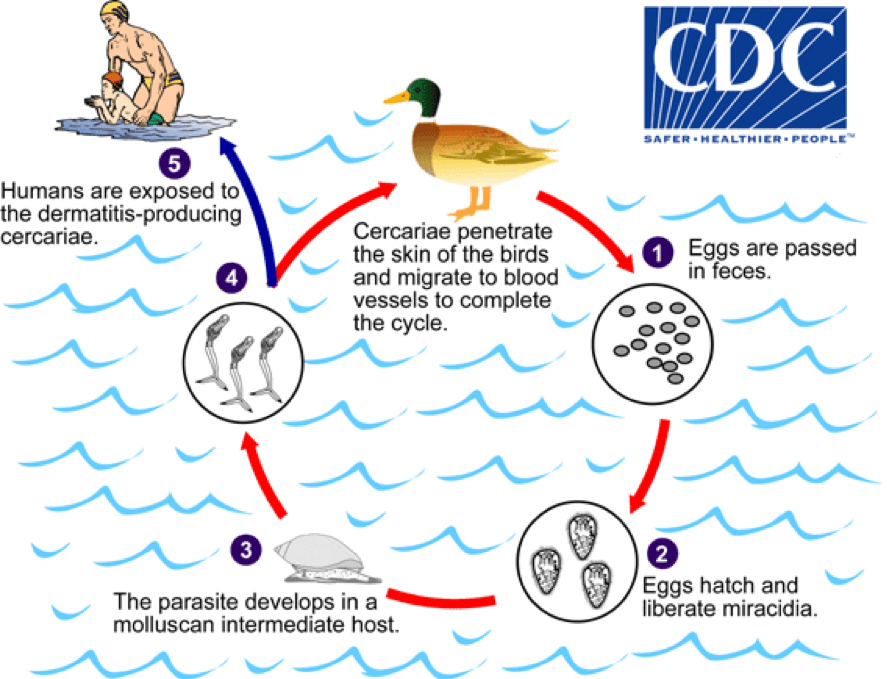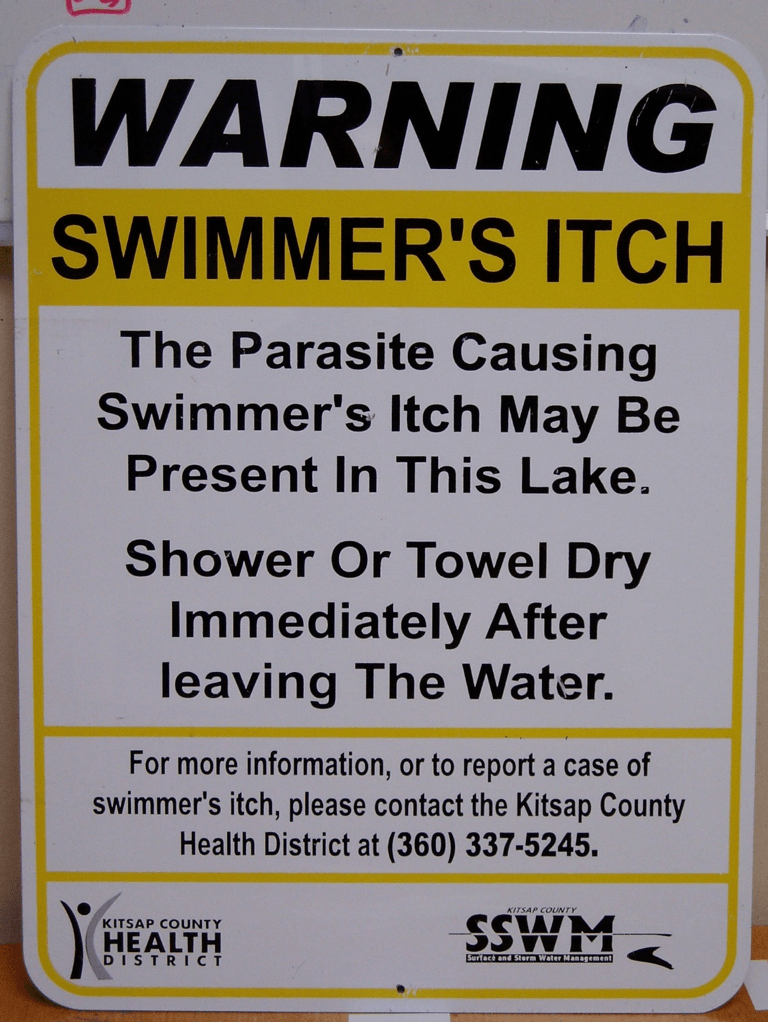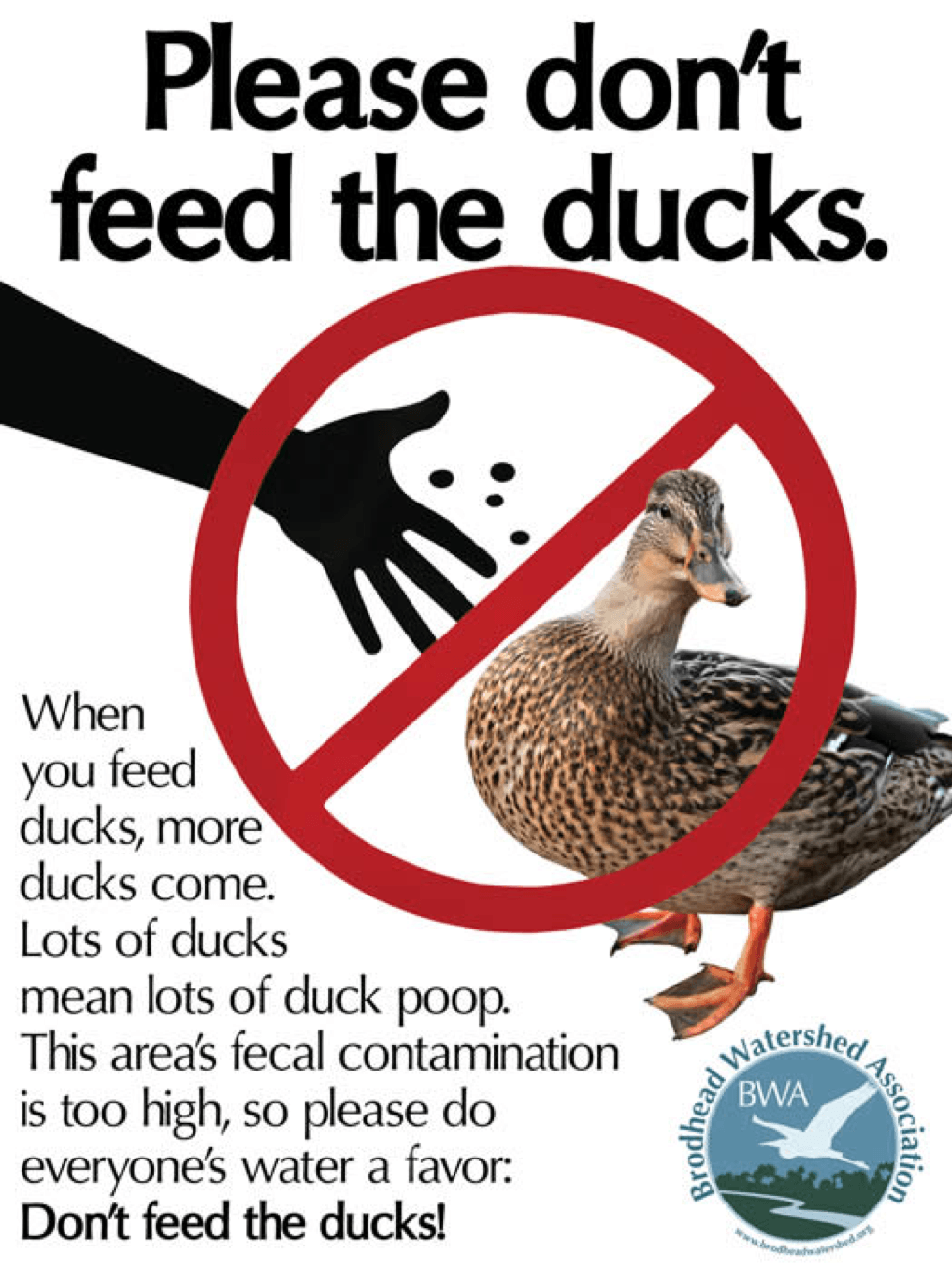
Swimmer’s Itch
Key Facts
Swimmer’s Itch is an itchy rash some people get when the larval stage of a certain parasitic flatworm burrows into their skin and dies.
Symptoms can also include low grade fever and light headedness lasting from a few hours to a few days.
Swimmer’s itch is a normal response of the human immune system to a foreign organism.
It has been reported in nearly every state in the United States, all provinces of Canada and 30 other countries.
During the summer of 2018, Torch Lake experienced really warm water (80 °F) and light wind conditions:
- Making the lake more inviting so more people were in it.
- Increasing the number of flatworms in the shallow waters, especially around the southern shores.
- Resulting in more complaints of Swimmer’s Itch.

Photo: Center for Disease Control
Swimmer’s Itch Cycle
The natural cycle involves 2 hosts for different life stages of the parasitic flatworm.
Step 1. In Michigan, Common Merganser ducks are the species that most commonly carries the Swimmer’s Itch flatworm in their digestive tract.
- Most all of the young Merganser chicks carry the flatworm while only half of the adult birds do.
- Merganser ducks can travel 1-2 miles along a shoreline each day.
- Mallard ducks, geese and even muskrats can carry different parasitic flatworm species.
Step 2. When an infected water fowl excretes, it releases the parasite flatworm eggs.
Step 3. In the water, the eggs hatch releasing swimming larvae which burrow into snails.
Step 4. In snails, the larvae further develop into wormlike larvae, called cercariae, and are released from their host snail back into the water.
Step 5. Microscopic cercariae then swim up toward the sunlight at the water surface and search for a Merganser duck. The cycle repeats itself, going back to Step 1.
The parasitic larvae cannot distinguish between duck and human, so they try to enter through your skin while wading and playing in the shallow water.

Image: Center for Disease Control
There are over 100 species of parasitic flatworms in the world.
In Michigan, there are at least 10 different species of parasitic flatworms.
Each species of flatworm uses only one species of snail and one species of bird to complete its lifecycle.
Did You Know?
20-25% of people have no reaction to the Swimmer’s Itch.
It makes no difference if your beach area is sandy, rocky or weedy as host snails will live on all sites.
Beaches are not closed based on reports of Swimmer’s Itch, but are for the presence of E. coli bacteria, which can lead to more serious health issues.

Photo: Kipsap County Washington
In the state of Washington, unlike Michigan, signs are posted to warn swimmers.
There is no effective way for people to eliminate swimmer’s itch from your swim area using chemical pesticides. Any attempts to control Swimmer’s Itch by treatment to kill either the cercariae or their snail hosts are:
- ineffective because cercariae are capable of swimming or drifting long distances from non-treated areas.
- would kill many non-target plants and animals and may also lead to contaminated sediments.
Remember–proposing any kind of pesticide or chemical treatment in the water for any purpose must obtain a permit from the Department of Natural Resources.
When and where can you get Swimmer’s Itch?
When:
The season’s first case of swimmer’s itch usually occurs after the first extended period of warm, calm weather in late May or early June.
It can persist throughout the summer season.
Where:
You are more likely to come in contact with the flatworm larvae when you are:
- Near the shore
- In shallow areas where waterfowl swim
- Moving rocks or docks in shallow water
Which shore area contains the parasitic flatworm larvae depends on numerous factors:
- Distribution and number of bird species infected with the parasitic flatworm
- Distribution and number of infected snail species
- Water and air temperature
- Wind direction and velocity
- Water currents
- Time of day
Making it hard to predict what beach is safe to swim in.
What can you do to reduce your chance of getting Swimmer’s Itch?
Like mosquito bites, you can reduce your exposure to Swimmer’s Itch:
- Try to create a waterproof barrier on your skin by applying sunscreen, baby oil, coconut oil or other lotions and then a swimmer’s itch cream before swimming. As of yet, an effective prevention cream has not been identified
- Swim offshore in deeper water
- Do not swim if winds are onshore
- Only stay in the water for short periods of time
- Rub briskly with a rough towel when you get out of the water
- Don’t sit around in your swimsuit
- Take a shower immediately when you get out of the water. Scrub with brown soap (Fels Naphtha) and a rough wash cloth
Once you get Swimmer’s itch, what is the treatment?
To treat swimmer’s itch once you have it:
To stop the initial tingling-wipe the area with white vinegar or salt water.
To stop the itching and to avoid secondary infection:
- Apply an over-the-counter topical anti-itch cream/ cortisone cream
- Take an over-the-counter anti-histamine
- If reaction is serious, seek medical assistance
Then, report your Swimmer’s Itch at swimmeritch.ca. This will take you to a Canadian survey. Click on Report your Itch.
Show
You Care
We know you want to enjoy the lake for many years (and generations) to come. So, we’ve put together a list of simple steps you can take to reduce the nutrients, sediments and toxins flowing into the lake and its streams.
What to do to reduce the chance your favorite beach has Swimmer’s Itch flatworm larvae?
Step 1. Don’t attract water birds by feeding them. Take photos of them instead.
More water birds pooping near your swim area increases the chance of having an infected water bird around your swim area.
Step 2. Maintain a shoreline buffer containing a variety of native trees, shrubs and plants to prevent waterfowl from gathering on and near your property. Or encourage your township to maintain a shoreline buffer at your favorite public access site.

Image: Brodhead Watershed Association
WATERpedia: the “One-Stop Shop” for Water Science A-Z
A-E
F-M
N-S
T-Z
Don't just wish that Torch Lake will stay blue.
Choose a water-friendly lifestyle - make a difference!
